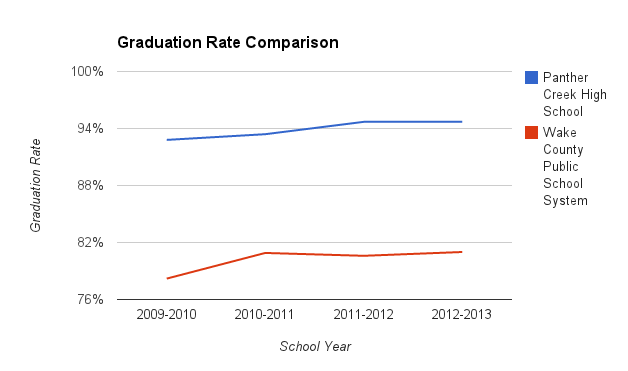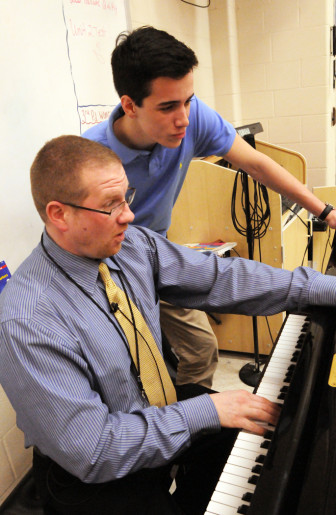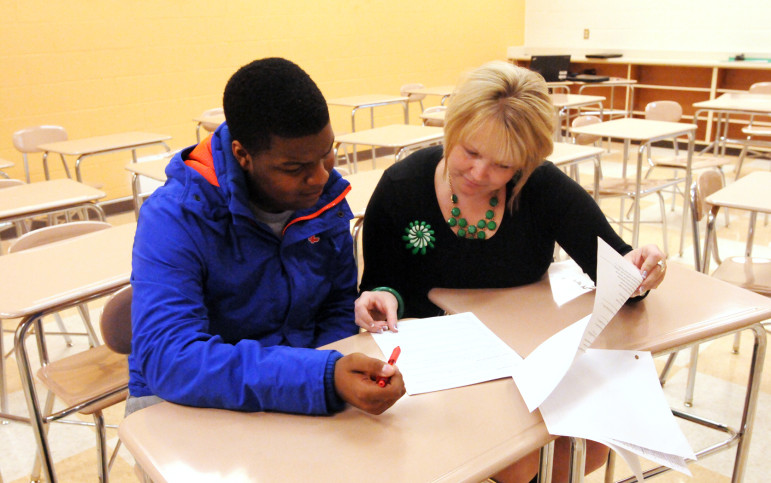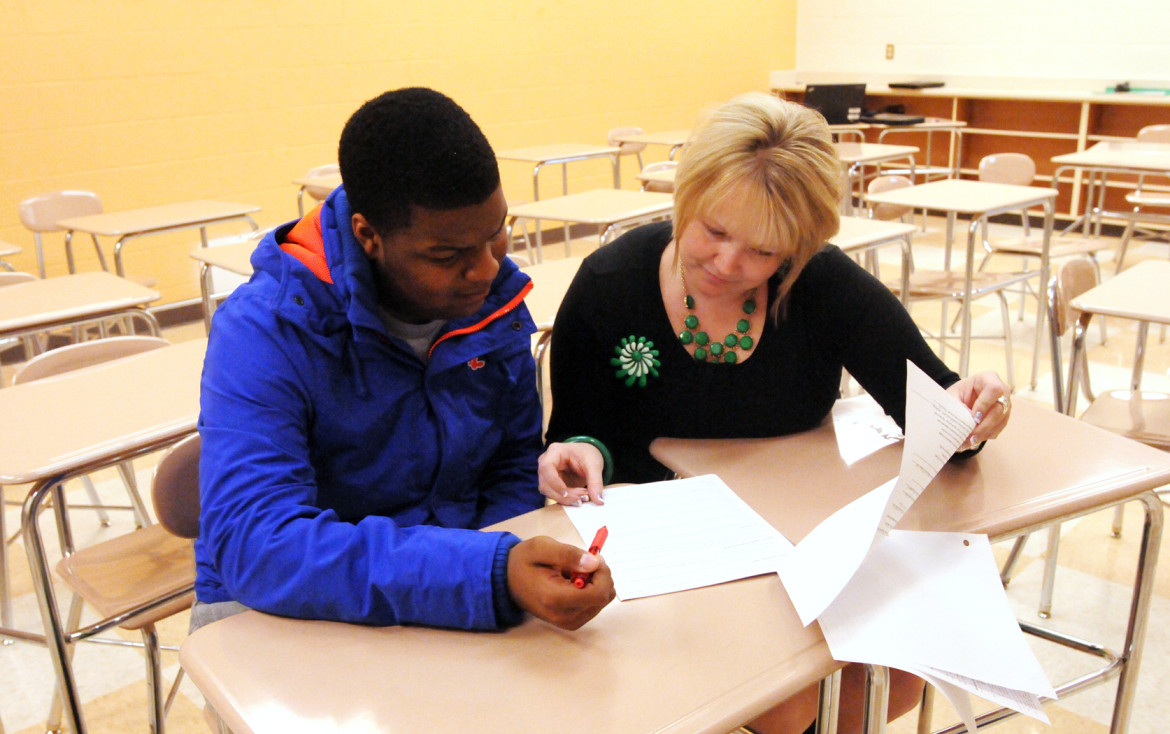Lunch is a very ordinary part of every high school student’s school day. But a lunchtime experiment at the county’s newest high school in Cary has led to extraordinary results — a 94.7 percent graduation rate.
SMART (Students Maximizing Achievement Relationships and Time) Lunch is the vision of Panther Creek High School Principal Rodney Nelson. Its effects, say students, teachers and administrators, are staggering.
The SMART lunch modifies the traditional lunch schedule so that every student and teacher in the school has a one-hour lunch period at the same time. Strict rules are in place regarding where students can and cannot eat. Part of the student population eats during the first 30 minutes while others are in SMART lunch. A bell rings after 30 minutes and they rotate.

Jeanna LaMotte-Kerr / Raleigh Public Record
Principal Rodney Nelson from Panther Creek High School.
During SMART lunch, students receive tutoring, participate in enrichment activities, make up tests, attend career conversations, meet with college admissions representatives, or participate in clubs and organizations. A schedule is posted of the subject areas holding SMART lunch programs each day of the week.
Panther Creek High School boasts one of the highest graduation rates in Wake County at 94.7 percent. Students in every subgroup see success at Panther Creek High School, including students with limited English proficiency, African-American students, Latino students, economically disadvantaged students and students with disabilities, according to data released by the state.
“If I were to name one thing that gets us those academic results, the achievement levels and the graduation rate, it’s SMART lunch,” Nelson said.

Source: NC Department of Public Instruction
Meeting the Needs of All Students
It’s easy to look at Panther Creek High School’s address in Cary and make assumptions about its success. However, the diversity of the school’s student population can be seen in the number of federal targets they are required to meet by No Child Left Behind — 36 — more than any other high school in Wake County.

Karen Tam / Raleigh Public Record
Left to right, teachers Gail Barkes, James Aldridge, Sarah Greco
The targets are broken down into specific student subgroups, including students with limited English proficiency, economically disadvantaged students, students with disabilities, and students from major racial and ethnic groups. Meeting a standard means the required percentage of students in that subgroup are proficient in the subject area.
Panther Creek High School is the only high school in Wake County to meet all of their federal standard targets for two consecutive years.
Panther Creek High School opened in 2006 with SMART lunch. Nelson acknowledges that having to build a school culture around the program comes with a different set of challenges than needing to change the existing school culture to build a successful SMART lunch program.
Nelson attributes the success of his school’s diverse learning community to the ability of his staff to meet the needs of every student.
“I think our staff really works hard to make sure that every kid is being given the opportunity to be successful,” he said. “There’s really no excuse for any kid to say, ‘I couldn’t get the kind of support from my teachers that I needed.’”
Panther Creek Social Studies teacher Danny Johnson said many students would love to stay after school for extra help or enrichment, but cannot because they do not have a ride home, they have to work or babysit younger siblings, or they have sports practice. Giving them the opportunity during the day, Johnson said, makes a big difference.
“It allows us to get involved in activities that we otherwise would not be able to do because we have too much on our plates already,” said Stephen Howard, a 12th grader at Panther Creek. “There are all these kids that have all these obligations after school, so SMART lunch gives us another time during the day that we’re allowed to get involved in these activities that otherwise we would not be able to.”
Nelson said it’s not just about helping those who need extra study time.
“We wanted it to be about remediation for some kids and enrichment for some kids, so that it wasn’t just for the kids that were performing at a lower level,” Nelson said. “We wanted SMART lunch to really be about supporting all kids and increasing their engagement.”
Implementing SMART Lunch at Other Schools
Several Wake County high schools are now using SMART lunch, including Green Hope High School, Cary High School and Athens Drive High School. School systems from across North Carolina as well as other states have contacted Nelson and expressed interest in the program.
Athens Drive High School Principal James Hedrick said SMART lunch gives his students a chance to re-engage with their teachers.
“This gives all students an opportunity during the course of the day to have some time set aside in which they can re-engage with their teachers over a variety of concepts, retake tests,” Hedrick said.
Panther Creek Biology teacher Gail Barkes said it’s important for each school to make it their own.
“Their student body is different than our student body. Their staff is different than our staff,” she said. “So you have to find what will work for your school and your environment. That’s one of the things that allowed us to be so successful, that we spent time planning it and making it ours.”

Karen Tam / Raleigh Public Record
Teacher Brad Bensen, left, works at the piano with senior Stephen Howard.
Brad McMillen, of Wake County Public School System’s Data and Accountability Department, said there are no plans to implement SMART lunch countywide.
“Every school has its own challenges and its own population. I mean they’re all working toward the same goal, but what the solution might be at a Green Hope or a Panther Creek may not be what’s needed at a Garner or a Holly Springs or a Wakefield,” McMillen said. “Ultimately the solutions that are implemented at each school are going to be individualized to the population.”
Fostering Student Connections
McMillen said dropout prevention research shows that one of the primary reasons children drop out of school is a lack of connection to the school and a lack of a sense of belonging.
That’s why relationships and building a sense of community within the school are integral to SMART lunch, Nelson said.
“The whole concept of SMART lunch is a relationship piece,” Nelson said. “It created pretty quickly for us a sense of community.
Panther Creek Math teacher Sarah Greco said relationships can have a big impact on at-risk students.
“Those might be the kids that you give the personal invitation to come to SMART lunch and that could make a huge difference.”
Tenth grade Panther Creek student Kyano Robinson is one of the students whose grades have improved with SMART lunch.
“My first semester I didn’t have the best grades,” Robinson said. “I knew what SMART lunch was but I didn’t really use it. But the second semester I figured out what it was, and I started going to one or two a day and my grades went up a lot.”

Karen Tam / Raleigh Public Record
Kyano Robinson, 10th grade, works with teacher Tracey Wooten.
Nelson said there are always students that do not use SMART lunch. Teachers or administrators work with them to create a SMART lunch schedule, but they are not punished.
Barkes said this helps students learn to take responsibility.
“SMART lunch was never intended to be punitive,” Barkes said. “It’s all about choices. It’s all about options. It’s all about time management, and I think that’s one of the life skills it helps students develop.”
